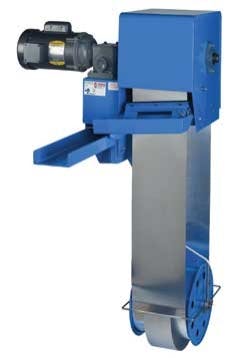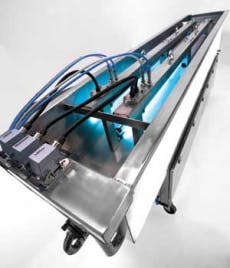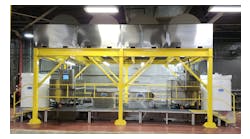Oil Skimmers Key to Refinery Anti-Pollution Plan
At a Texas petrochemical refinery, the addition of oil skimmers has improved the cleanliness and efficiency ofTwo stainless-steel Abanaki Corp. Model 8 oil skimmers with 40 gph capacity were selected for the project.
The company estimates that the oil skimmers will pay for themselves in less than two years and save more than $2000 per year thereafter by eliminating the cost of wastewater disposal.
The plant maintenance managers decided on oil skimming after considering several approaches. Doing nothing was not an option because the water cannot be discharged into the sewer without risk of fines from the EPA, the Texas Commission on Environmental Quality, and the municipal sewer authority.
In this case, a belt skimmer was chosen because they offer a wide choice of skimming media that can be matched to the application. Two stainless-steel Abanaki Corp. Model 8 oil skimmers with 40 gph capacity were selected.
The oil skimmers work by using the basic physical principles of surface tension and relative density. As the rotating belt turns, it passes through the floating layer of oil at the surface. The oil sticks to the belt, as it is more oleophilic than water. The oil is then drawn across the surface of the container as the product near the belt is removed. This same process removes any floating hydrocarbon, including gasoline and other light fuels.
Mounted over a pit, the oil skimmers drive the belt with a ¼ horsepower motor. Relatively simple devices, they require almost no maintenance and are built to provide many years of reliable service.
The refinery required skimmers constructed of stainless steel because of the nature of some of the organic compounds being manufactured in the facility. Because these products are not oil, belt selection was a carefully controlled process involving the testing of samples provided by Abanaki.
After the maintenance department evaluated the pickup rates and estimated life spans of four different materials, a looped fuzzy belt was selected for its superior performance with these chemicals. The fuzzy belt has dramatically more surface area than typical smooth belts. It is covered with synthetic "hairs" to pick up thin hydrocarbons at a rate similar to picking up motor oil with a standard belt.
Given the volatile nature of a refinery, explosion-proof motors and electrical controls were supplied for the skimmers. Drum shut-offs ensure that even if not checked regularly, the collection container will not over flow. This allows minimal maintenance and supervision over the skimming process.
Firms Team to Provide Shale Gas Wastewater Treatment
Layne Christensen and Aqua-Pure Ventures have entered into a Teaming Agreement to jointly promote a combination of their respective technologies for the treatment and disposal of flowback, produced water and other applicable waste streams.
The goal is to provide a turnkey solution for pre-treatment, re-use and disposal of wastewater using both mobile and permanent facilities.
"We are extremely pleased to have an arrangement with an industry leader like Aqua-Pure, which has developed a highly cost-effective and viable wastewater recycling process in the industry," said Greg Aluce, Layne's President of Water Technologies. "We believe our combined marketing efforts and technical expertise have the potential to position us as a formidable player in the rapidly expanding shale gas market."
The companies expect their combined capabilities to provide opportunities across North America. They also anticipate opportunities to collaborate globally in heavy oil, power, mining and other related industries.
Since 2004, Aqua-Pure has developed and refined its technology for recycling flowback and produced water, and has recycled roughly 600 million gallons of wastewater in the Barnett Shale. The treated water, which would otherwise have been injected into disposal wells and permanently removed from the hydrological cycle, is instead re-used in drilling operations.
Aqua-Pure's technology is now being deployed in the Marcellus Shale, at Eureka Resources' water treatment facility in Williamsport, PA. Its Nomad units are now recycling up to 300,000 gallons of wastewater every day from a wide range of producers.
UV Disinfection Helps Research Facility Meet Wastewater Discharge RegulationsA Berson OpenLine open channel UV wastewater disinfection system like the one shown here has been installed at the Wilsonville Power Systems Development Facility in Alabama.
UV disinfection specialist Berson has helped the Wilsonville Power Systems Development Facility (PSDF) in Alabama comply with strict wastewater discharge regulations. In four years of operation, contaminants have been kept within permit limits with minimal maintenance.
The Wilsonville facility is a research and development center that tests coal-based technologies before they are implemented at power supply facilities. In 2006, the growing plant employed 200 people and produced a wastewater flow of about 25 gallons per minute.
With its size expected to double in the near future, the facility was required by state and local regulators to start disinfecting its wastewater. The existing wastewater treatment facility in Wilsonville was too far away for the facility to connect. Therefore, the PSDF decided to build its own wastewater treatment facility.
After evaluating competing products, Wilsonville PSDF selected Berson's OpenLine UV disinfection system, which uses low pressure, high output UV lamps.
The state permit required that no single sample of the water leaving the Wilsonville PSDF could have more than 200 fecal colonies per 100 ml. The UV system has provided the necessary disinfection required to meet the site's permit. In addition, the system offers a compact footprint and requires virtually no maintenance. The OpenLine has operated for 21,000 hours since installation, meeting disinfection requirements without needing UV lamp replacement.
Tire Plant Saves Nearly 10 Million Gallons Annually
The BF Goodrich tire manufacturing plant in Woodburn, IN, has significantly reduced water and chemical usage while simultaneously increasing efficiency with help from GE's water chemical technology.
The water supply at the Woodburn facility comes from a well that produces very hard water, resulting in the need to chemically treat the water that is used for boiler feedwater in the steam systems. Lower quality water was not allowing the boiler systems to run at optimal levels, thus limiting efficiency and increasing water usage. BF Goodrich turned to GE to help develop a solution.
With the installation of a reverse osmosis (RO) system and with the proper chemical treatment program, BF Goodrich improved the quality of the boiler make-up water, which allowed for an increase in total boiler cycles, leading to fuel cost savings. The tire manufacturing plant now conserves 9.9 million gallons of water annually, reducing the impact on the environment. The company also reduced operating expenses and improved overall safety conditions. These improvements resulted in the facility earning a GE ecomagination Leadership Award.
Other savings included a reduction in steam, as well as an elimination of costs for sludge removal to a landfill and elimination of costs for chemicals such as lime and soda ash. GE's solution also enabled the Woodburn facility to improve safety conditions by reducing the amount of chemicals needed to treat the boiler water.
"The improvements to our boilers and make-up water after installing GE's water treatment system resulted in fewer mechanical issues and less chemical handling by the operators," said Paul Cagle, plant manager at BF Goodrich's Woodburn facility. "This is a significant improvement, especially from an EHS standpoint, because it reduces the chances for accidents or injury to our operators."
Company Develops AlternativeTesting Method for Food Processing
3M Food Safety has launched a new alternative to agar petri dishes for testing water in beverage and food processing plants.
The company's 3M™ Petrifilm™ Aqua Plates contain a water-soluble gelling agent, nutrients and indicators that test for the four most common contaminates that threaten a company's product: heterotrophic count, coliform, yeast and mold, and enterobacteriaceae.
Today's beverage and food processers often produce their own agars or purchase premade dishes. Both practices require a large investment in employee time, excessive refrigeration space and unnecessary waste. The new sample-ready plates provide consistent quality, ease-of-use, and increased productivity, while creating less waste and using less storage space.
An industry study conducted with 292 food-processing plants demonstrated an 80 percent increase in technician productivity (tests per hour), saving companies an average of 3.7 hours per day of technician time. Consequently, the saved time can be redirected to more value-adding activities such as increased sampling, production monitoring and HACCP programming.
To learn more about purchasing or testing 3M Petrifilm Aqua Plates, visit www.3M.com/foodsafety.
Past IWW Issues



